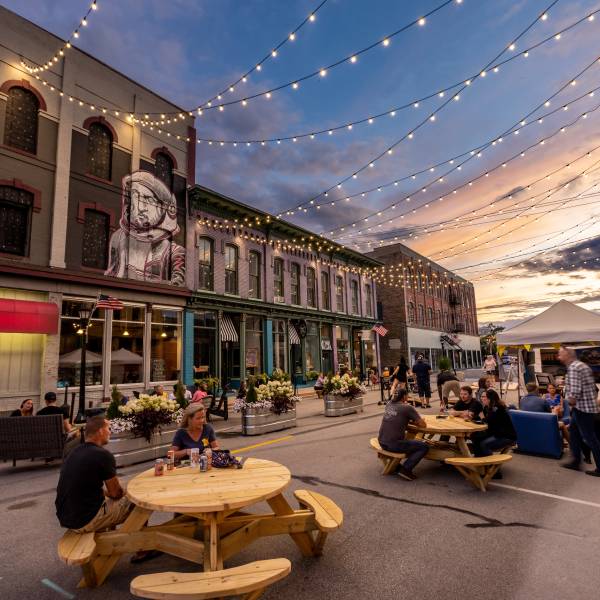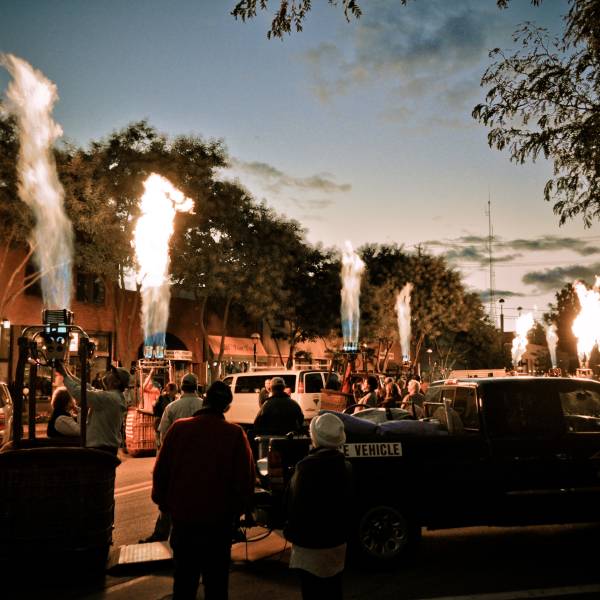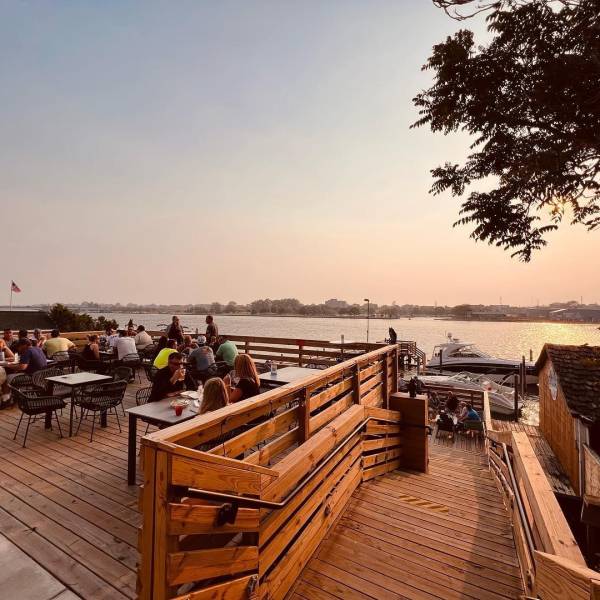A MESSAGE FROM MICHIGAN'S GREAT LAKES BAY REGIONAL CVB
Dear esteemed stakeholders and partners,
It is with great pleasure that we present to you our tourism master plan for our Go Great Lakes Bay destination. This comprehensive document embodies our vision, strategies, and actions aimed at fostering sustainable growth and development within the tourism sector.
As a destination, we have been blessed with an abundance of natural beauty, cultural heritage, and unique experiences that have captivated visitors from around the world. Our tourism master plan aims to harness these assets to create a destination that not only thrives economically but also preserves and enhances our natural and cultural heritage.
This plan is the result of extensive research, stakeholder consultations, and a deep understanding of the changing global tourism landscape. It is designed to address the challenges and opportunities that lie ahead, ensuring that our destination remains competitive, resilient, and inclusive.
Our vision for the future is one of sustainable tourism that balances economic growth, environmental stewardship, and social well-being. We aspire to create a destination that not only benefits our residents and businesses but also leaves a positive impact on the lives of our visitors and residents.
To achieve this vision, our tourism master plan focuses on four key pillars:
- Destination Development: We aim to enhance our infrastructure, services, and attractions to create a world-class destination that caters to the diverse needs and interests of our visitors. This includes the development of sustainable accommodation, transportation, and recreational facilities, as well as the preservation and promotion of our natural and cultural heritage.
2. Marketing and Promotion: We recognize the importance of effective marketing and promotion in attracting visitors to our destination. Our plan includes targeted marketing campaigns, digital innovation, and strategic partnerships to position ourselves as a must-visit destination in the global tourism market.
3. Community Engagement and Empowerment: Our success as a destination relies on the engagement and support of our local communities. We are committed to involving residents, businesses, and other stakeholders in decision-making processes, empowering them to take an active role in shaping the future of our tourism industry.
4. Sustainable Tourism Practices: Environmental sustainability is at the core of our tourism master plan. We are dedicated to adopting responsible and sustainable practices that minimize negative impacts on our environment, conserve natural resources, and protect the well-being of our ecosystems. We will work closely with the tourism industry to promote responsible tourism practices and ensure the long-term viability of our destination.
We firmly believe that this tourism master plan will guide us towards a prosperous and sustainable future. However, its success relies on the collective efforts and collaboration of all stakeholders. We invite you to join us in implementing this plan, contributing your expertise, resources, and ideas to shape the future of our destination.
Together, we can create a destination that not only fulfills the dreams and aspirations of our visitors but also preserves the beauty and authenticity that make our destination truly unique.
Thank you for your unwavering support and commitment to our destination.
Yours in hospitality,
Annette M. Rummel, Ph.D.
CEO + Tourism Trailblazer
INTRODUCTION
This tourism master plan was created to identify, innovate, and articulate potential products, amenities, programming, and experiences, along with corresponding policies and protocols that will guide the long-term sustainable planning and design of Michigan’s Great Lakes Bay Region as a tourism destination.
When fully implemented, this plan will provide economic sustainability for the visitor economy in the region while preserving the quality of life for our residents and ensuring quality experiences for visitors.
This project was made possible through EDA Cares Act funding.

MARKET ANALYSIS + CURRENT CONDITIONS
The following section includes key challenges and opportunities along with a review of recent factors that have had a significant impact on Go Great Lakes Bay, including the COVID-19 pandemic and the effects of the 100-year flood.
OPPORTUNITIES
Winter experience development
There was strong support for expanding the promotion of the region’s abundance of outdoor recreation experiences to bolster winter visitation. Efforts to advocate for wayfinding and amenities, such as year-round facilities, will serve to further develop winter options.
Access to water
Access to water trails on rivers, marshes, and the Saginaw Bay, needs to be improved. To expand sensory-friendly experiences and access to soft adventure we should encourage the development of accessible launches for all abilities, including beach facilities and a riverfront boardwalk.
Brand and awareness
There is a need to build a stronger base of local brand ambassadors. This will be achieved by educating and encouraging residents to discover the many unique experiences across the region. From there, additional story-telling opportunities should be created to heighten brand awareness at the state and national levels.
Industry collaboration and support
To enhance stakeholder engagement, networking, and communication, Go Great Lakes Bay should share resources and data with industry partners.
Water-related experiences
There was strong sentiment around ensuring visitors experience the incredible natural waterfront assets throughout the region. Availability of adaptable kayak and boat rentals, exploring scuba training and dive locations, kite surfing, and boat camping at transient docks were discussed.
Environmental sustainability and stewardship
Appreciating and protecting the bountiful natural resources is a priority throughout the region. There is a desire to attract visitors who respect the values reflected by residents.
Agritourism
The agricultural sector threads its way throughout the region offering ample opportunities to showcase farm-to-table dining, hands-on harvesting, educational tourism, and sustainability best practices.
Voluntourism
Voluntourism is a combination of volunteering and tourism in which travelers participate in voluntary work, typically for charity, while visiting a destination. It is anticipated to rise well into the future.
CHALLENGES
Nightlife (including dining)
Whether it’s after a hockey game, theatrical production, or concert, there is a lack of options to have a cocktail or enjoy dinner after 8 pm. There is a strong desire for expanded evening entertainment, live music, and dining hours.
Sense of place
It’s common for stakeholders and residents to be the harshest critics of their community, which makes it challenging to celebrate or identify the distinct attributes that set MGLBR apart from other areas. Many discussions resulted in comparisons between communities in the region, rather than a unified destination.
Access, connectivity, and mobility
While public transportation exists, the schedule is limited, and the service is underutilized. Ride-share and a robust public transportation network are critical for an improved visitor experience. Access to broadband is also critical.
Diversity of experiences
Long-standing events have created rich traditions. The need for new experiences and a greater variety of events to attract visitors and generate renewed interest from residents still remains.
Local engagement
Education is needed for residents to appreciate the visitor economy's full value. Connecting them as brand ambassadors, event volunteers, and providing opportunities to share feedback will assist in creating a better understanding.
Inclusivity + Diversity
Much of this feedback was focused on mobility/access, neuro-sensitivity/autism awareness, and ensuring everyone feels welcome. Incorporating indigenous culture into the destination experience will contribute to inclusivity and diversification of the product.
KEY TAKEAWAYS
- Natural assets and recreation such as the Tridge, trails, and waterways are prime opportunities for enhanced/new experiences, including waterfront developments, a public/private pier, launches, dining, housing, and retail.
- There is a strong desire to activate downtown corridors with festivals, pop-up businesses, and events (year-round).
- Collaborating with the Indigenous community to create authentic cultural experiences/attractions is possible.
- There is a strong opportunity to expand winter and off-peak offerings that are unique to the region that is not dependent on snow.
- Development of agritourism interactive experiences (harvesting, farm-to-table, tours) will draw new visitors.
- There is overwhelming support for improved public transportation, including air service, ride-share, and regional trolley/shuttle service.
- Public safety concerns, perceptions, and blight must be addressed.
- Trail connectivity and wayfinding need to be expanded across the region.
- A dynamic vibe that entices young professionals and creates energy must be developed.

Assessing The Impact Of The Pandemic And Historic Flooding
It’s important to acknowledge the devastation that occurred throughout the region’s hospitality sector because of COVID-19 restrictions implemented in March 2020 followed by the 100-year flooding event in May of that year. Recovery continues in the three counties where these catastrophic events impacted businesses at varying levels. Although multiple hospitality-related businesses were shuttered during that time, several new businesses opened despite these challenges.
REGIONWIDE
Data shows that visitors to MGLBR are concentrating their time in the larger centers, specifically in the downtowns. Visitors are also traveling to universities, medical districts, and well-established draws like Frankenmuth.

MIDLAND COUNTY
In Midland County, heat mapping shows most visitors spend their time downtown, with some traveling north to the education and medical districts.

SAGINAW COUNTY
In Saginaw County, visitors are primarily spending their time in downtown Saginaw, at the University, and in Frankenmuth.
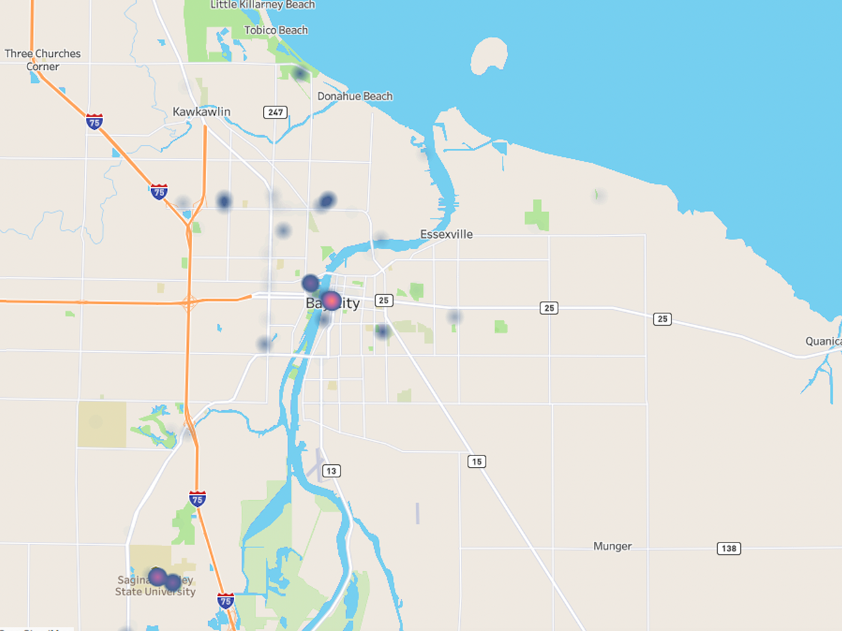
BAY COUNTY
In Bay County, most visitors are staying in the downtown and along the water in the core, as opposed to the beaches. Visitors are also traveling to Saginaw Valley State University.
COMPETITIVE DIFFERENTIATORS
Access to Water
The region is perfectly positioned between Lake Huron, Saginaw Bay and multiple rivers to provide memorable experiences. River access is ideal for kayaking, stand up paddleboarding (SUP) and miles of scenic waterfront trails. The serene waters of Saginaw Bay are ideal for sightseeing cruises, hands-on Tall Ship excursions, charter fishing and the largest contiguous freshwater coastal wetland system in the U.S.
In addition, the Shiawassee National Wildlife Refuge features an abundance of wildlife and birding in a natural setting. These soft adventures provide visitors with mobility or neuro-sensitivity issues the opportunity to enjoy the outdoors and make lifelong memories.
Proximity to Population
The drive market remains as a primary focus for promotion and the Great Lakes Bay region is uniquely positioned to capitalize on accessibility to major metropolitan hubs. Proximity to first tier cities such as Detroit and Toronto provide a significant base of visitors with diverse interests to draw from. Grand Rapids and Toledo offer secondary target markets all within a few hours’ drive. Touting an easy journey as part of the adventure sets Great Lakes Bay apart from the competition.
Unexpected Experiences
Insight gained through SMARI's market analysis indicated perceptions of the region are neutral or positive, primarily due to lack of familiarity with the amenities and experiences available for visitors. Opportunities to share the diverse attributes of each community through storytelling serves to inform visitors, inspire travel to the destination and distinguish their individual identities within the region. Engaging visitors to share unexpected moments or capture their favorite experiences generates a library of user generated content with authentic messaging that will resonate with followers. Utilizing influences and travel writers will further expand reach to broader audiences.
Keen on Cannabis
Until federal legislation exists, Michigan and Great Lakes Bay stand to benefit from the growing popularity surrounding cannabis tourism. Neighboring Ohio legalized possession of small amounts of marijuana but recreational use is still prohibited, and Indiana is currently exploring the possibility of legalization, but statutes prohibit possession which provides an opportunity for promoting local access and responsible consumption to this niche market. This differentiator reinforces proximity as a distinction for Great Lakes Bay.
Access to Ag
The agricultural sector threads its way throughout the region offering ample opportunities to showcase farm-to-table dining, hands-on harvesting, educational tourism, and sustainability best practices. Desire for one of a kind experiential travel and voluntourism is anticipated to continue rising well into the future.
Affordable Options
Increasing cost of goods and inflation are impacting future travel bookings, however, Great Lakes Bay stands out as an affordable destination, particularly when compared with other Michigan communities where lodging, dining and attractions are significantly more expensive. Visitors originating from larger cities or Canada will find the significant cost savings appealing. Venue pricing and catering services for meetings, conventions and sports competitions could also be enticed with the ability to stretch their budgets further.
Cruising
Expanding partnerships with Cruise the Great Lakes to include the region as a port of call will bring significant benefits including media events, direct access to cruise lines, enhanced social media presence and promotion through Cruise Lines Int’l Assn (CLIA). Bay City has the required infrastructure to accommodate cruise ships. The opportunity to develop unique, experiential shore excursions to provide cruise lines fresh itinerary options will expand this as a differentiator for the region.
DIFFERENTIATORS UNIQUE TO THE GREAT LAKES BAY REGION
Frankenmuth
Frankenmuth is the Region’s greatest differentiator, with dozens of annual festivals and hundreds of events, Bavarian-style architecture, family-friendly accommodations, and the world’s largest year-round Christmas ornament store.
Santa House
A strong seasonal attraction that welcomes visitors to meet Santa and tour his workshop.
Midland Canopy Walk at Dow Gardens
The longest Canopy Walk in the United States is a draw for outdoor enthusiasts and birders.
Dow Chemical
Global headquarters of Dow Chemicals which brings business travel, investment, and awareness to the Region.
Sister City Relationships
Saginaw has a well-established Sister City relationship with Tokushima, Japan that has resulted in several unique experiences in Saginaw, including the Japanese Cultural Center and one of the most authentic Japanese tea houses in North America. Frankenmuth’s Sister City relationship with Gunzenhausen, Germany has been ongoing since 1962 and brings visitation through annual exchange programs and other activities.
CONCLUSION
To further stand out in a competitive landscape in Michigan, the United States and globally, the Great Lakes Bay region must continue to find differentiators in products and experiences that will give visitors compelling reasons to visit. Modeling communities after Frankenmuth and its experiences will also support the growth of interest and unique assets in the region.
ASSET MAP
TOURISM ASSETS AND CROSS VISITATION:
Great Lakes Bay Region
Tourism Assets and Cross Visitation:
GREAT LAKES BAY REGION

Distribution of Assets and Visits
(% share of total)
Source: Near
All markets have a higher share of visits than number of assets

Visitor Share
(% share of total visits — residents vs visitors)
Source: Near
Visitors are a vital part of the regional economy, but residents also take advantage of the many activities and attractions available to them

Visitation by Point of Interest
(% share of total visits)
The Premium Outlets is the most visited location in Great Lakes with 80% of the visits coming from outside the region

Resident to Visitor Ratio
(Visits to tourism -related assets, score above 1 = a higher number of visitors than residents)
Source: Near
At a 1.8 visitor to resident score, tourism assets in Saginaw County rely heavily on traffic from visitors
Tourism Assets and Cross Visitation:
BAY COUNTY

Distribution of Assets and Visits
(% share of total)
Source: Near
Bay County has a high share of dispensaries, fairgrounds / festivals, and fishing locations in the region which is also represented in the high share of visits

Visitor Share
(% share of total visits — residents vs visitors)
Source: Near
Fishing locations in Bay County are heavily used by both visitors and residents. Most other assets are underutilized from a visitor standpoint

Visitation by Point of Interest
(% share of total visits)
Majority of Bay County’s tourism assets are concentrated in Bay City

Cross Visitation by Visitors to Bay County
(Excludes residents in the Great Lakes Region)
Source: Near
7-in-10 visitors to Bay County, also travel to Saginaw County during their trip while only 1/3 go to Midland County
Tourism Assets and Cross Visitation:
MIDLAND COUNTY

Distribution of Assets and Visits
(% share of total)
Source: Near
Midland County has a high share of sporting arenas and venues, but also a high share of non-tourism sector locations

Visitor Share
(% share of total visits — residents vs visitors)
Source: Near
Midland County has the least tourism assets out of the three counties in the region, and as a result, rely more on traffic from residents

Visitation by Point of Interest
(% share of total visits)
Midland Mall is the most visited tourism location in Midland County and nearly all assets are concentrated in Midland City

Cross Visitation by Visitors to Midland County
(Excludes residents in the Great Lakes Region)
Source: Near
¾ of visitors to Midland County spend time in Midland City, and more than 50% of travelers also visit the neighboring counties
Tourism Assets and Cross Visitation:
SAGINAW COUNTY

Distribution of Assets and Visits
(% share of total)
Source: Near
Saginaw County has the most assets and visitation to tourism-related locations out of the three destinations

Visitor Share
(% share of total visits — residents vs visitors)
Source: Near
With majority of the hotels and attractions in the region located in Saginaw County, it is well positioned to host more overnight visitors

Visitation by Point of Interest
(% share of total visits)
The Premium Outlets is the most visited location in Saginaw County with 80% of the traffic coming form outside the region

Cross Visitation by Visitors to Saginaw County
(Excludes residents in the Great Lakes Region)
Source: Near
Nearly 50% visitors to Saginaw County, also travel to Bay County, while 21% also visit Midland County
PRODUCT GAP ANALYSIS:
Physical/Geographic Assets
Developing the visitor economy in a three-county region can be a challenge for the visitor experience and for stakeholders. The lack of current continuity and connection in MGLBR may not be a barrier to visitation, but it is a barrier to the exploration of the broader region and may be a limiting factor in repeat visitation.
The broad vision for the region is to be “A welcoming and inclusive region that celebrates our four seasons, natural assets, distinct experiences, connectivity, and shared community values”. Adopting a sense of place that aligns with the broader vision should be inclusive and incorporate the natural and cultural assets of the area.
Approaching this opportunity with a regional mindset among all three counties will support connectivity and consistency so visitors feel they are part of the greater region. This will also help educate them about the unique communities in which they are arriving and visiting.
This work extends to downtowns, ensuring they have appropriate lighting, activations that support vibrancy and activity, and a general sense of community. A region-wide public arts program can also support sense of place efforts throughout the three counties. Recommendations for new infrastructure developments should include alignment with consistent placemaking opportunities so visitors and locals see and feel the connection and sense of place and community.
This gap analysis uncovered multiple gaps and opportunities to be addressed, including:
- Dining past 8pm
- Shopping past 7pm
- Nightlife for young professionals
- Indigenous experiences
- Agritourism experiences
- Indoor family experiences
- All-abilities experiences
- Sensory experiences
- An iconic attraction
- Effective region-wide wayfinding
- Region-wide event
- Waterfront dining
- Recreational water experiences
- Adequate transportation options
- Ride sharing services
- Air service
PRODUCT GAP ANALYSIS: Destination Vision
The shared vision for MGLBR is an aspiration for the year 2033 created with input from all stakeholders.
IN 2034 THE GREAT LAKES BAY REGION WILL BE:
A welcoming and inclusive region that celebrates our four seasons, natural assets, distinct experiences, connectivity and shared community values.
It was important to all stakeholder groups that MGLBR continues to work toward having experiences for visitors and locals all year round. That desire, coupled with celebrating the natural assets of the region that are derived from the four seasons, is expressed in the language.
With the regional aspiration to have more distinctive experiences that will serve as differentiators for the region and the brand, there is a great opportunity to further develop our communities and their offerings for the benefit of residents and visitors alike.
Improving regional connectivity has also been a significant topic of conversation. Improved air access will benefit the region by bringing new visitors to the area, while improved transportation infrastructure will support drive-market visitation and those already in-market. Additionally, countywide transit, wayfinding, and rideshare services will support both residents and visitors.
We must maintain the strong values found in our Region’s communities. These include family, friendliness, warmth, support of others, and kindness. We must celebrate these attributes. This long-term vision balances sustainable visitor growth with our community’s long-term health, vibrancy, and values.
Considering the vision for the region, economically and environmentally sustainable development opportunities exist, including:
Information Gaps:
It is important to note that through this process, gaps were identified specifically related to value and funding requirements of the development of experiences. Specific feasibility studies will address these issues.
PRODUCT GAP ANALYSIS: Placemaking Opportunities
Placemaking is a significant aspect of the Tourism Master Plan and supports both our visitors in feeling like they’re part of a community and our residents in developing and maintaining their pride in our region. Placemaking is often credited with increasing vibrancy, safety, increased economic impact, and new business opportunities because it does exactly what its name suggests; it creates a sense of place that people care about.
Frankenmuth is a prime example of strong placemaking. The main street is lit in a purposeful and stylish way, the sidewalks are walkable, there are trash bins available, there are frequent events, the experiences are close together and the architecture has a common theme. Architecture does not always need a consistent or common look and feel to support great placemaking, but connectivity, walkability, lighting, events, and experiences are key.
Placemaking opportunities begin when visitors arrive in the region. There are opportunities for collaboration with MBS airport to create a stronger sense of arrival in MGLBR with digital imagery from around the region, showcasing all there is to do in the season, or promoting upcoming events, etc.
These opportunities also extend to a sense of arrival and welcome in each city and town. For example, visitors always know when they have arrived in Frankenmuth, Downtown Birch Run, and Midland because of the archways and signage. However, this sense of arrival and welcome does not exist in other destinations throughout the three-county region. Working collaboratively, with a regional destination mindset, it is recommended that each city and town develop a sense of welcome.
This placemaking opportunity should then extend to the city centers and downtowns throughout the region. These areas are crucial to placemaking and creating vibrant communities. By activating the core of each city or town with events, walkability, lighting, music, etc., we develop a sense of place that makes people want to visit. All of this is important not just during the daytime but in the evenings as well. Ensuring businesses are open later will bring people downtown - or encourage them to stay after work - and will ensure the businesses thrive. To support moving people throughout the region, offering rotating late-night hours is a viable option. When people visit and there is a sense of vibrancy and activity, safety increases, businesses benefit from the increased traffic, and new businesses are drawn to the area.
Downtown Midland has begun placemaking with fire pits on the sidewalks in the winter and flower beds in the summer, and this is an important starting point for a community with young professionals. Increasingly, young people are seeking communities which offer vibrancy, local culinary options, and retail. Each downtown area in the MGLBR can focus on placemaking, which may result in vibrancy, economic development, and talent attraction to the area.
WHAT IS PLACEMAKING?
What Makes A Great Place...
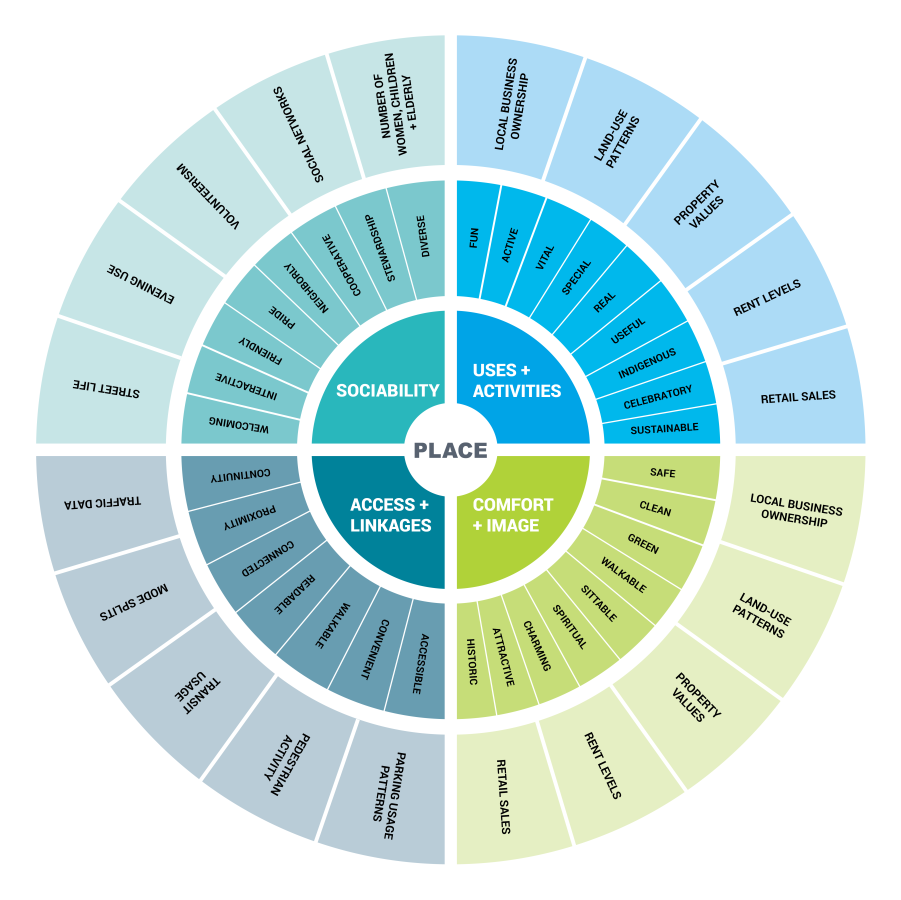
PRODUCT GAP ANALYSIS: Development Opportunities
The strategic goals provide the framework for decision-making regarding efforts and investments to enhance the visitor economy in MGLBR. These goals offer guidance on how to achieve the overarching vision and develop a competitive positioning for MGLBR as a destination. These strategic goals and the subsequent initiatives will support the retention, enhancements, marketing, diversification, growth, and additional sales of industry partners and assets within the region.
It is important to note that MGLBRCVB will play a role in each strategic goal, however, that role will vary. Partner organizations will also participate in the implementation and success of these goals for the benefit of the region.
STRATEGIC GOAL #1:
Support Improved Transportation Options
MGLBR is currently a destination best explored and accessed by vehicle. Expanding the access and mobility options available to visitors who want to visit the region will increase the number of visitors and the demographics of visitors, particularly as fuel prices continue to rise. Increased mobility options within the region will also change visitor behavior and increase economic impact as they won’t be as concerned with being required to take their own vehicle everywhere they go.
Enhancing local connectivity and mobility options will also support the regional workforce, as workers without their own vehicles will have options to get them to and from their places of employment. This will enable both employees and employers to expand their reach and recruiting and retention options.
INITIATIVES
Suggested KPIs to measure Strategic Goal #1 – Support improved transportation options
- # of new air routes secured
- Improved rideshare access regionwide
- Improved options for non-vehicular transportation options
STRATEGIC GOAL #2:
Develop Waterfronts
MGLBR evokes thoughts of fun and dynamic waterfront experiences just from its name. By developing the waterfronts with experiences, events, retail and culinary options and Great Lakes Cruising porting opportunities, the region will deliver on its brand promise. It will also continue to attract new residents and retain existing ones thanks to the vibrancy and opportunities the waterfront will offer.
INITIATIVES
Suggested KPIs to measure Strategic Goal #2 - Develop waterfronts
- Money invested in waterfront development
- Number of new experiences developed
- TripAdvisor ratings
- Visitor satisfaction score
STRATEGIC GOAL #3:
Increase Accessibility Options
Travelers of all demographics face accessibility challenges. Whether it be physical abilities, sensory-related abilities, neurodiversity or others, travelers actively seek destinations that can accommodate their needs and make it commonplace to do so.
Having a destination that is accessible to all automatically makes it a more welcoming place that is better for its residents and guests.
INITIATIVES
Suggested KPIs to measure Strategic Goal #3 - Increase accessibility options
- TripAdvisor ratings
- Number of businesses who participate
- Number of accessibility options available
STRATEGIC GOAL #4:
Enhance Recreation Opportunities
Recreational experiences are sought out by residents and visitors alike. For visitors, recreational activities offer an active and unique way to explore a destination and many visitors seek destinations with diverse and plentiful outdoor recreation offerings. For residents, recreational offerings are part of what contributes to quality of life and quality of place.
By offering diverse recreational opportunities, the region will attract new visitors and support its efforts to retain and attract residents.
INITIATIVES
Suggested KPIs to measure Strategic Goal #4 - Enhance recreation opportunities
- Improved DNEXT score in 2025
- Resident sentiment score
- Number of new related-businesses
STRATEGIC GOAL #5:
Incorporate Sustainable Development
Sustainable development relates to two primary factors: economic sustainability and environmental sustainability. Both are critical to the future of MGLBR. Economic sustainability is about ensuring that the economy can thrive; that the workforce is strong and able to live fulfilling and prosperous lives within the region.
Environmental sustainability ensures that MGLBR maintains an ecological balance in our natural environment and that we conserve our natural resources to support the wellbeing of our residents and to the benefit of our visitors. We will strive to protect our natural assets from overuse, encourage a litter free environment, promote recycling, and leave no trace behind. We will ensure visitors and residents know what they can do to protect and preserve the natural resources of the region.
INITIATIVES
Suggested KPIs to measure Strategic Goal #5 - Incorporate Sustainable Development
- Hospitality industry placement rate
- Number of frontline employees graduating from training program
STRATEGIC GOAL #6:
Bolster Investments In Destination Development
Supporting our partners in sourcing funding opportunities will benefit the long-term health and development of the region, including our brand, jobs, talent attraction and retention, economic development, the visitor economy, and more.
These initiatives will support the retention, enhancements, marketing, diversification, growth and additional sales of industry partners and assets within the region.
INITIATIVES
Suggested KPIs to measure Strategic Goal #6 - Bolster Investments In Destination Development
- Investment $ for product development
- Dollar of grants secured
STRATEGIC GOAL #7:
Advocate For Improved Infrastructure Amenities
Quality infrastructure is essential for visitors as it ensures reliable communication, well-maintained amenities, safe well-lit environment, and efficient services. This enhances their overall experience, increases satisfaction, and encourages them to return in the future.

THE FUTURE IS BRIGHT
Strategic Plan
As we plan for a strategic post-pandemic and flood recovery, we know that we can’t do it alone. Feedback from all of you supported the development of this plan. We will undoubtedly emerge and successfully recover as we Go Great, Together.
WHERE BRAND MEETS BUSINESS
Post-pandemic, our region has changed as a destination. This plan develops a strategy that outlines how our branding and messaging should adjust through an eventual and successful travel rebound.
Read The Plan +
The Power To Keep Growing
With a vision of becoming a welcoming and inclusive region that celebrates our four seasons, natural assets, distinct experiences, connectivity, and shared community values, four strategic goals related to Experience Development were identified for the region.
Read More +














































